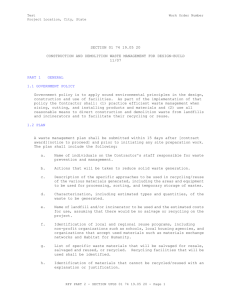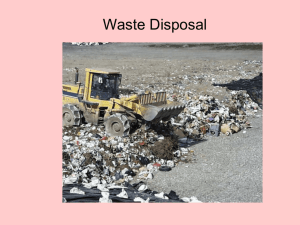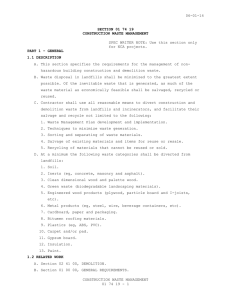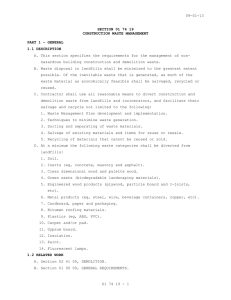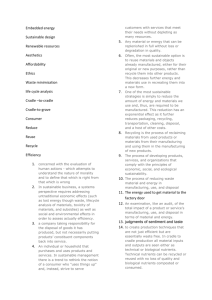Summary of Modifications/Changes in this Update
advertisement
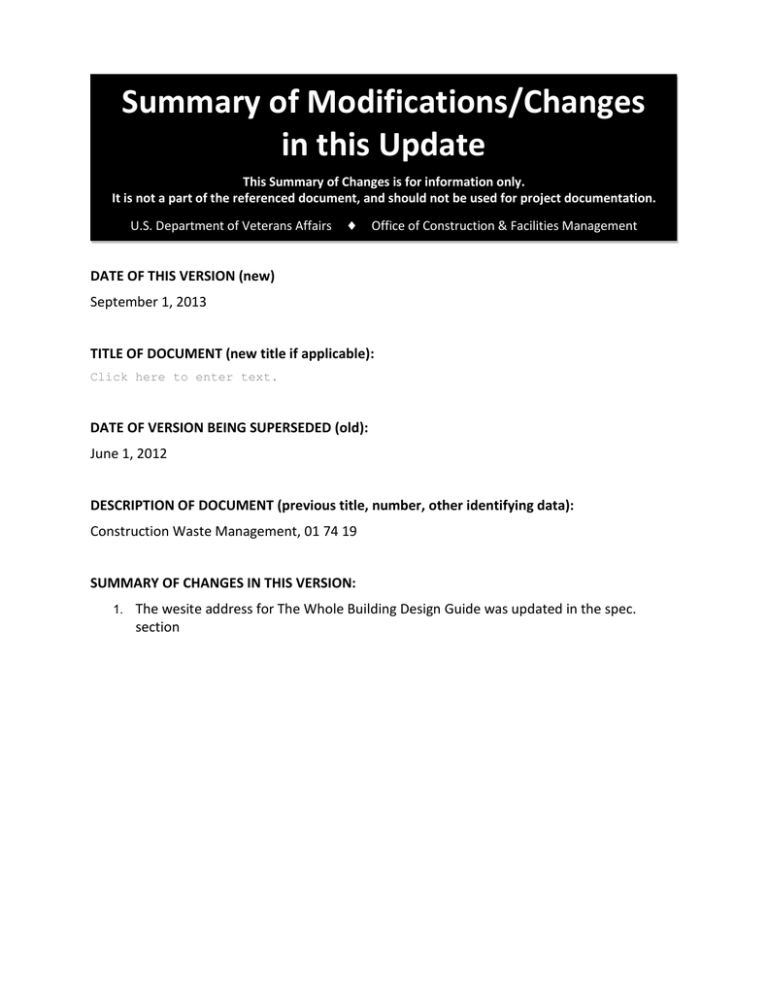
Summary of Modifications/Changes in this Update This Summary of Changes is for information only. It is not a part of the referenced document, and should not be used for project documentation. U.S. Department of Veterans Affairs ♦ Office of Construction & Facilities Management DATE OF THIS VERSION (new) September 1, 2013 TITLE OF DOCUMENT (new title if applicable): Click here to enter text. DATE OF VERSION BEING SUPERSEDED (old): June 1, 2012 DESCRIPTION OF DOCUMENT (previous title, number, other identifying data): Construction Waste Management, 01 74 19 SUMMARY OF CHANGES IN THIS VERSION: 1. The wesite address for The Whole Building Design Guide was updated in the spec. section 09-01-13 SECTION 01 74 19 CONSTRUCTION WASTE MANAGEMENT PART 1 – GENERAL 1.1 DESCRIPTION A. This section specifies the requirements for the management of nonhazardous building construction and demolition waste. B. Waste disposal in landfills shall be minimized to the greatest extent possible. Of the inevitable waste that is generated, as much of the waste material as economically feasible shall be salvaged, recycled or reused. C. Contractor shall use all reasonable means to divert construction and demolition waste from landfills and incinerators, and facilitate their salvage and recycle not limited to the following: 1. Waste Management Plan development and implementation. 2. Techniques to minimize waste generation. 3. Sorting and separating of waste materials. 4. Salvage of existing materials and items for reuse or resale. 5. Recycling of materials that cannot be reused or sold. D. At a minimum the following waste categories shall be diverted from landfills: 1. Soil. 2. Inerts (eg, concrete, masonry and asphalt). 3. Clean dimensional wood and palette wood. 4. Green waste (biodegradable landscaping materials). 5. Engineered wood products (plywood, particle board and I-joists, etc). 6. Metal products (eg, steel, wire, beverage containers, copper, etc). 7. Cardboard, paper and packaging. 8. Bitumen roofing materials. 9. Plastics (eg, ABS, PVC). 10. Carpet and/or pad. 11. Gypsum board. 12. Insulation. 13. Paint. 14. Fluorescent lamps. 1.2 RELATED WORK A. Section 02 41 00, DEMOLITION. B. Section 01 00 00, GENERAL REQUIREMENTS. 01 74 19 - 1 09-01-13 C. Lead Paint: Section 02 83 33.13, LEAD BASED PAINT REMOVAL AND DISPOSAL. 1.3 QUALITY ASSURANCE A. Contractor shall practice efficient waste management when sizing, cutting and installing building products. Processes shall be employed to ensure the generation of as little waste as possible. Construction /Demolition waste includes products of the following: 1. Excess or unusable construction materials. 2. Packaging used for construction products. 3. Poor planning and/or layout. 4. Construction error. 5. Over ordering. 6. Weather damage. 7. Contamination. 8. Mishandling. 9. Breakage. B. Establish and maintain the management of non-hazardous building construction and demolition waste set forth herein. Conduct a site assessment to estimate the types of materials that will be generated by demolition and construction. C. Contractor shall develop and implement procedures to recycle construction and demolition waste to a minimum of 50 percent. D. Contractor shall be responsible for implementation of any special programs involving rebates or similar incentives related to recycling. Any revenues or savings obtained from salvage or recycling shall accrue to the contractor. E. Contractor shall provide all demolition, removal and legal disposal of materials. Contractor shall ensure that facilities used for recycling, reuse and disposal shall be permitted for the intended use to the extent required by local, state, federal regulations. The Whole Building Design Guide website http://www.wbdg.org/tools/cwm.php provides a Construction Waste Management Database that contains information on companies that haul, collect, and process recyclable debris from construction projects. F. Contractor shall assign a specific area to facilitate separation of materials for reuse, salvage, recycling, and return. Such areas are to be kept neat and clean and clearly marked in order to avoid contamination or mixing of materials. 01 74 19 - 2 09-01-13 G. Contractor shall provide on-site instructions and supervision of separation, handling, salvaging, recycling, reuse and return methods to be used by all parties during waste generating stages. H. Record on daily reports any problems in complying with laws, regulations and ordinances with corrective action taken. 1.4 TERMINOLOGY A. Class III Landfill: A landfill that accepts non-hazardous resources such as household, commercial and industrial waste resulting from construction, remodeling, repair and demolition operations. B. Clean: Untreated and unpainted; uncontaminated with adhesives, oils, solvents, mastics and like products. C. Construction and Demolition Waste: Includes all non-hazardous resources resulting from construction, remodeling, alterations, repair and demolition operations. D. Dismantle: The process of parting out a building in such a way as to preserve the usefulness of its materials and components. E. Disposal: Acceptance of solid wastes at a legally operating facility for the purpose of land filling (includes Class III landfills and inert fills). F. Inert Backfill Site: A location, other than inert fill or other disposal facility, to which inert materials are taken for the purpose of filling an excavation, shoring or other soil engineering operation. G. Inert Fill: A facility that can legally accept inert waste, such as asphalt and concrete exclusively for the purpose of disposal. H. Inert Solids/Inert Waste: Non-liquid solid resources including, but not limited to, soil and concrete that does not contain hazardous waste or soluble pollutants at concentrations in excess of water-quality objectives established by a regional water board, and does not contain significant quantities of decomposable solid resources. I. Mixed Debris: Loads that include commingled recyclable and nonrecyclable materials generated at the construction site. J. Mixed Debris Recycling Facility: A solid resource processing facility that accepts loads of mixed construction and demolition debris for the purpose of recovering re-usable and recyclable materials and disposing non-recyclable materials. K. Permitted Waste Hauler: A company that holds a valid permit to collect and transport solid wastes from individuals or businesses for the purpose of recycling or disposal. 01 74 19 - 3 09-01-13 L. Recycling: The process of sorting, cleansing, treating, and reconstituting materials for the purpose of using the altered form in the manufacture of a new product. Recycling does not include burning, incinerating or thermally destroying solid waste. 1. On-site Recycling – Materials that are sorted and processed on site for use in an altered state in the work, i.e. concrete crushed for use as a sub-base in paving. 2. Off-site Recycling – Materials hauled to a location and used in an altered form in the manufacture of new products. M. Recycling Facility: An operation that can legally accept materials for the purpose of processing the materials into an altered form for the manufacture of new products. Depending on the types of materials accepted and operating procedures, a recycling facility may or may not be required to have a solid waste facilities permit or be regulated by the local enforcement agency. N. Reuse: Materials that are recovered for use in the same form, on-site or off-site. O. Return: To give back reusable items or unused products to vendors for credit. P. Salvage: To remove waste materials from the site for resale or re-use by a third party. Q. Source-Separated Materials: Materials that are sorted by type at the site for the purpose of reuse and recycling. R. Solid Waste: Materials that have been designated as non-recyclable and are discarded for the purposes of disposal. S. Transfer Station: A facility that can legally accept solid waste for the purpose of temporarily storing the materials for re-loading onto other trucks and transporting them to a landfill for disposal, or recovering some materials for re-use or recycling. 1.5 SUBMITTALS A. In accordance with Section 01 33 23, SHOP DRAWINGS, PRODUCT DATA, and SAMPLES, furnish the following: B. Prepare and submit to the Resident Engineer a written demolition debris management plan. The plan shall include, but not be limited to, the following information: 1. Procedures to be used for debris management. 2. Techniques to be used to minimize waste generation. 3. Analysis of the estimated job site waste to be generated: 01 74 19 - 4 09-01-13 a. List of each material and quantity to be salvaged, reused, recycled. b. List of each material and quantity proposed to be taken to a landfill. 4. Detailed description of the Means/Methods to be used for material handling. a. On site: Material separation, storage, protection where applicable. b. Off site: Transportation means and destination. Include list of materials. 1) Description of materials to be site-separated and self-hauled to designated facilities. 2) Description of mixed materials to be collected by designated waste haulers and removed from the site. c. The names and locations of mixed debris reuse and recycling facilities or sites. d. The names and locations of trash disposal landfill facilities or sites. e. Documentation that the facilities or sites are approved to receive the materials. C. Designated Manager responsible for instructing personnel, supervising, documenting and administer over meetings relevant to the Waste Management Plan. D. Monthly summary of construction and demolition debris diversion and disposal, quantifying all materials generated at the work site and disposed of or diverted from disposal through recycling. 1.6 APPLICABLE PUBLICATIONS A Publications listed below form a part of this specification to the extent referenced. Publications are referenced by the basic designation only. In the event that criteria requirements conflict, the most stringent requirements shall be met. B. U.S. Green Building Council (USGBC): LEED Green Building Rating System for New Construction 1.7 RECORDS Maintain records to document the quantity of waste generated; the quantity of waste diverted through sale, reuse, or recycling; and the quantity of waste disposed by landfill or incineration. Records shall be kept in accordance with the LEED Reference Guide and LEED Template. 01 74 19 - 5 09-01-13 PART 2 - PRODUCTS 2.1 MATERIALS A. List of each material and quantity to be salvaged, recycled, reused. B. List of each material and quantity proposed to be taken to a landfill. C. Material tracking data: Receiving parties, dates removed, transportation costs, weight tickets, tipping fees, manifests, invoices, net total costs or savings. PART 3 - EXECUTION 3.1 COLLECTION A. Provide all necessary containers, bins and storage areas to facilitate effective waste management. B. Clearly identify containers, bins and storage areas so that recyclable materials are separated from trash and can be transported to respective recycling facility for processing. C. Hazardous wastes shall be separated, stored, disposed of according to local, state, federal regulations. 3.2 DISPOSAL A. Contractor shall be responsible for transporting and disposing of materials that cannot be delivered to a source-separated or mixed materials recycling facility to a transfer station or disposal facility that can accept the materials in accordance with state and federal regulations. B. Construction or demolition materials with no practical reuse or that cannot be salvaged or recycled shall be disposed of at a landfill or incinerator. 3.3 REPORT A. With each application for progress payment, submit a summary of construction and demolition debris diversion and disposal including beginning and ending dates of period covered. B. Quantify all materials diverted from landfill disposal through salvage or recycling during the period with the receiving parties, dates removed, transportation costs, weight tickets, manifests, invoices. Include the net total costs or savings for each salvaged or recycled material. C. Quantify all materials disposed of during the period with the receiving parties, dates removed, transportation costs, weight tickets, tipping fees, manifests, invoices. Include the net total costs for each disposal. 01 74 19 - 6 09-01-13 - - - E N D - - - 01 74 19 - 7


